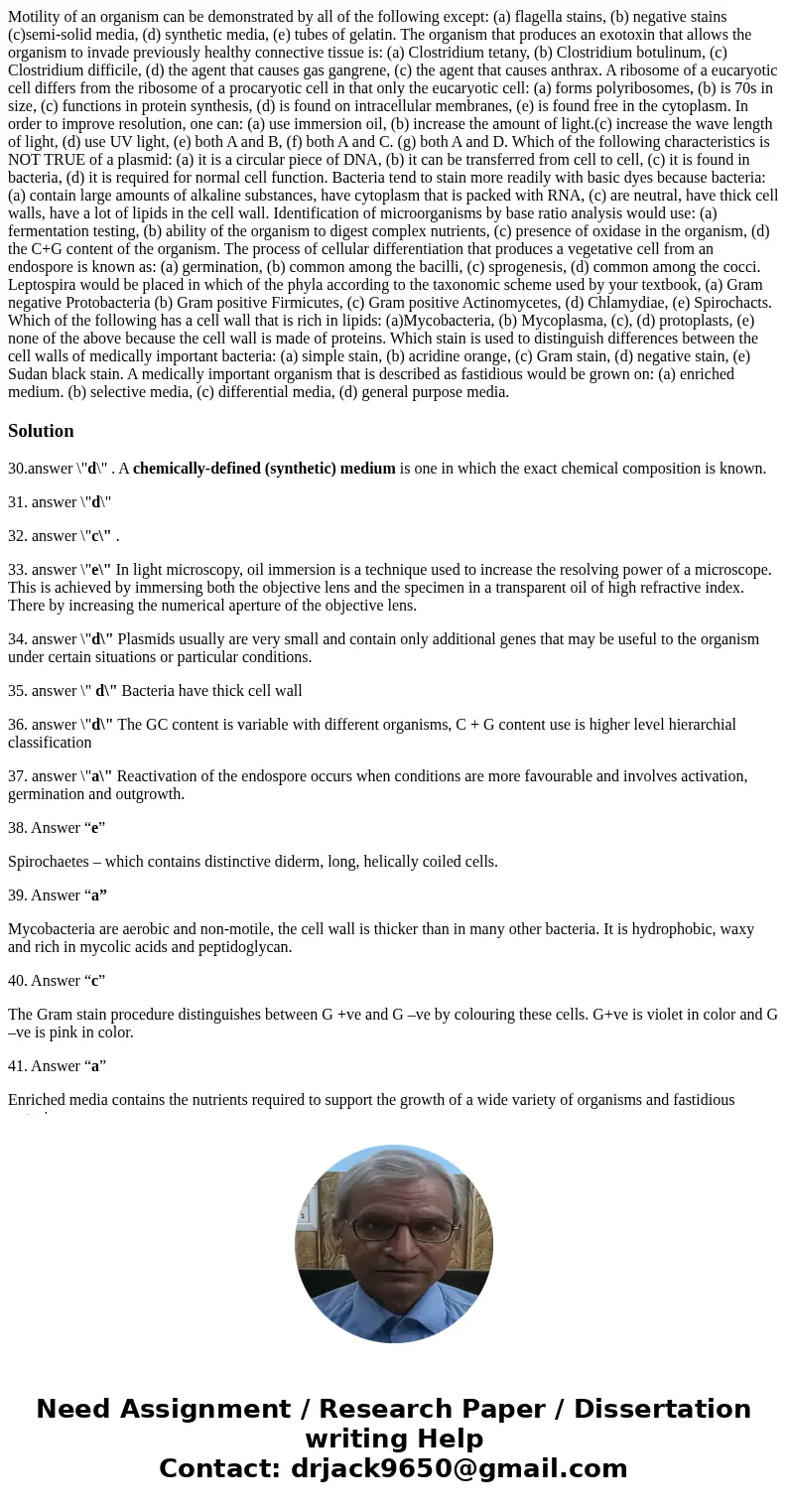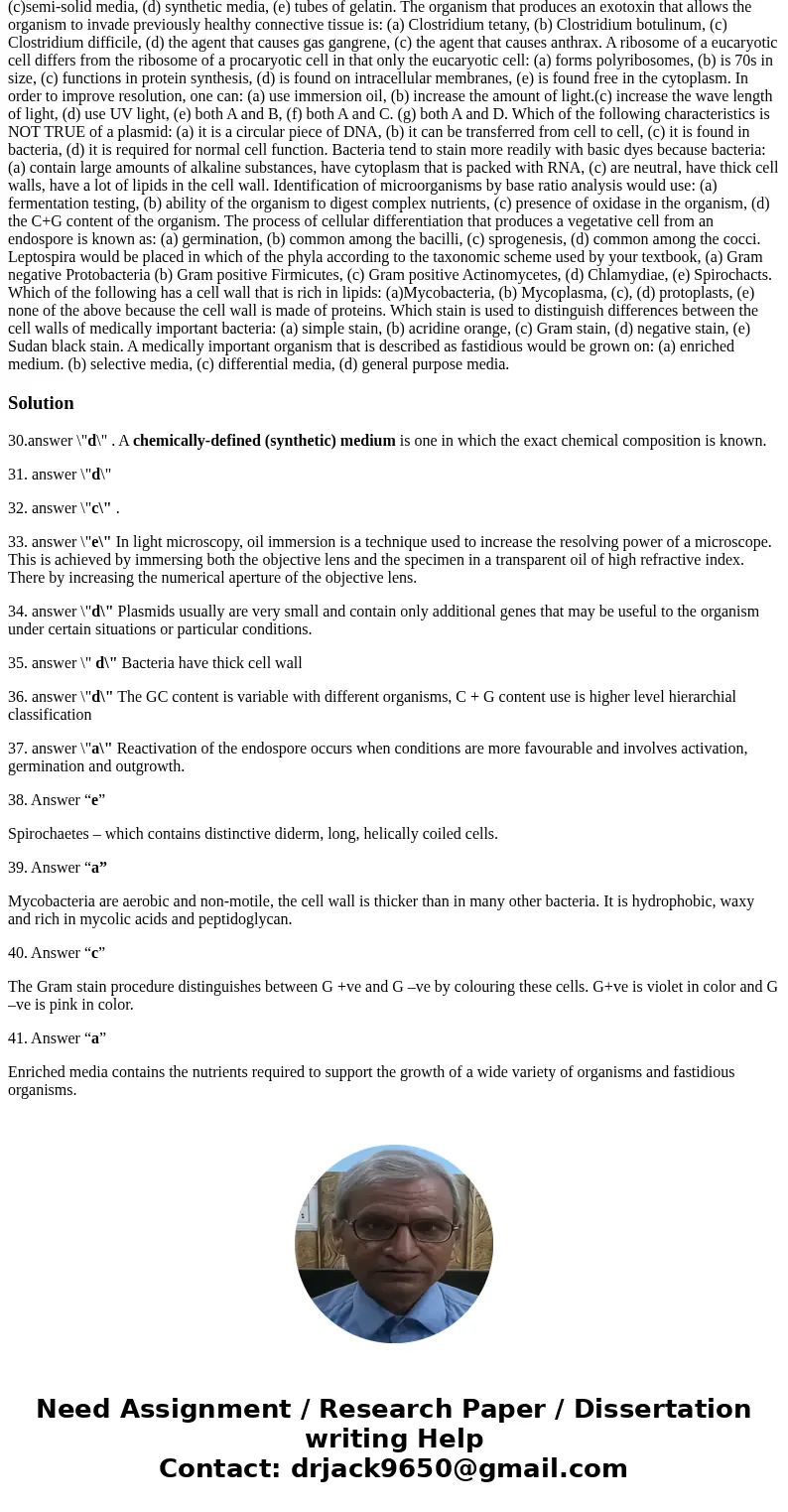Motility of an organism can be demonstrated by all of the following except: (a) flagella stains, (b) negative stains (c)semi-solid media, (d) synthetic media, (e) tubes of gelatin. The organism that produces an exotoxin that allows the organism to invade previously healthy connective tissue is: (a) Clostridium tetany, (b) Clostridium botulinum, (c) Clostridium difficile, (d) the agent that causes gas gangrene, (c) the agent that causes anthrax. A ribosome of a eucaryotic cell differs from the ribosome of a procaryotic cell in that only the eucaryotic cell: (a) forms polyribosomes, (b) is 70s in size, (c) functions in protein synthesis, (d) is found on intracellular membranes, (e) is found free in the cytoplasm. In order to improve resolution, one can: (a) use immersion oil, (b) increase the amount of light.(c) increase the wave length of light, (d) use UV light, (e) both A and B, (f) both A and C. (g) both A and D. Which of the following characteristics is NOT TRUE of a plasmid: (a) it is a circular piece of DNA, (b) it can be transferred from cell to cell, (c) it is found in bacteria, (d) it is required for normal cell function. Bacteria tend to stain more readily with basic dyes because bacteria: (a) contain large amounts of alkaline substances, have cytoplasm that is packed with RNA, (c) are neutral, have thick cell walls, have a lot of lipids in the cell wall. Identification of microorganisms by base ratio analysis would use: (a) fermentation testing, (b) ability of the organism to digest complex nutrients, (c) presence of oxidase in the organism, (d) the C+G content of the organism. The process of cellular differentiation that produces a vegetative cell from an endospore is known as: (a) germination, (b) common among the bacilli, (c) sprogenesis, (d) common among the cocci. Leptospira would be placed in which of the phyla according to the taxonomic scheme used by your textbook, (a) Gram negative Protobacteria (b) Gram positive Firmicutes, (c) Gram positive Actinomycetes, (d) Chlamydiae, (e) Spirochacts. Which of the following has a cell wall that is rich in lipids: (a)Mycobacteria, (b) Mycoplasma, (c), (d) protoplasts, (e) none of the above because the cell wall is made of proteins. Which stain is used to distinguish differences between the cell walls of medically important bacteria: (a) simple stain, (b) acridine orange, (c) Gram stain, (d) negative stain, (e) Sudan black stain. A medically important organism that is described as fastidious would be grown on: (a) enriched medium. (b) selective media, (c) differential media, (d) general purpose media.
30.answer \"d\" . A chemically-defined (synthetic) medium is one in which the exact chemical composition is known.
31. answer \"d\"
32. answer \"c\" .
33. answer \"e\" In light microscopy, oil immersion is a technique used to increase the resolving power of a microscope. This is achieved by immersing both the objective lens and the specimen in a transparent oil of high refractive index. There by increasing the numerical aperture of the objective lens.
34. answer \"d\" Plasmids usually are very small and contain only additional genes that may be useful to the organism under certain situations or particular conditions.
35. answer \" d\" Bacteria have thick cell wall
36. answer \"d\" The GC content is variable with different organisms, C + G content use is higher level hierarchial classification
37. answer \"a\" Reactivation of the endospore occurs when conditions are more favourable and involves activation, germination and outgrowth.
38. Answer “e”
Spirochaetes – which contains distinctive diderm, long, helically coiled cells.
39. Answer “a”
Mycobacteria are aerobic and non-motile, the cell wall is thicker than in many other bacteria. It is hydrophobic, waxy and rich in mycolic acids and peptidoglycan.
40. Answer “c”
The Gram stain procedure distinguishes between G +ve and G –ve by colouring these cells. G+ve is violet in color and G –ve is pink in color.
41. Answer “a”
Enriched media contains the nutrients required to support the growth of a wide variety of organisms and fastidious organisms.


 Homework Sourse
Homework Sourse